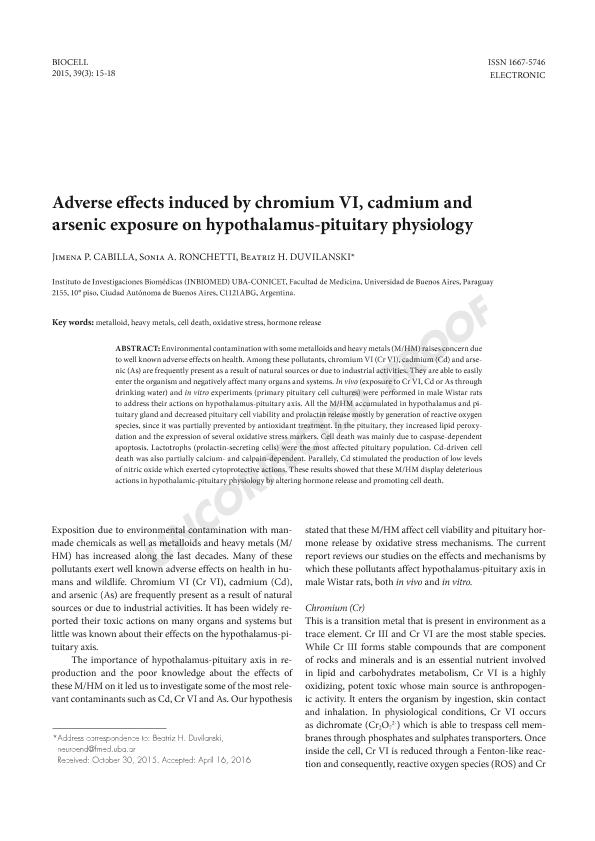Artículo
Adverse effects induced by chromium VI, cadmium and arsenic exposure on hypothalamus-pituitary physiology
Fecha de publicación:
04/2016
Editorial:
Instituto de Histología y Embriología Dr. Mario H. Burgos (IHEM-CONICET)
Revista:
Biocell
ISSN:
1667-5746
Idioma:
Inglés
Tipo de recurso:
Artículo publicado
Clasificación temática:
Resumen
Environmental contamination with some metalloids and heavy metals (M/HM) raises concern due to well known adverse effects on health. Among these pollutants, chromium VI (Cr VI), cadmium (Cd) and arsenic(As) are frequently present as a result of natural sources or due to industrial activities. They are able to easily enter the organism and negatively affect many organs and systems. In vivo (exposure to Cr VI, Cd or As through drinking water) and in vitro experiments (primary pituitary cell cultures) were performed in male Wistar rats to address their actions on hypothalamus-pituitary axis. All the M/HM accumulated in hypothalamus and pituitary gland and decreased pituitary cell viability and prolactin release mostly by generation of reactive oxygen species, since it was partially prevented by antioxidant treatment. In the pituitary, they increased lipid peroxydation and the expression of several oxidative stress markers. Cell death was mainly due to caspase-dependentapoptosis. Lactotrophs (prolactin-secreting cells) were the most affected pituitary population. Cd-driven cell death was also partially calcium- and calpain-dependent. Parallely, Cd stimulated the production of low levels of nitric oxide which exerted cytoprotective actions. These results showed that these M/HM display deleterious actions in hypothalamic-pituitary physiology by altering hormone release and promoting cell death.
Palabras clave:
Metalloid
,
Heavy Metals
,
Cell Death
,
Oxidative Stress
,
Hormone Release
Archivos asociados
Licencia
Identificadores
Colecciones
Articulos(BIOMED)
Articulos de INSTITUTO DE INVESTIGACIONES BIOMEDICAS
Articulos de INSTITUTO DE INVESTIGACIONES BIOMEDICAS
Articulos(INBIOMED)
Articulos de INSTITUTO DE INVESTIGACIONES BIOMEDICAS
Articulos de INSTITUTO DE INVESTIGACIONES BIOMEDICAS
Citación
Cabilla, Jimena Paula; Ronchetti, Sonia Alejandra; Duvilanski, Beatriz Haydee; Adverse effects induced by chromium VI, cadmium and arsenic exposure on hypothalamus-pituitary physiology; Instituto de Histología y Embriología Dr. Mario H. Burgos (IHEM-CONICET); Biocell; 39; 4-2016; 15-18
Compartir




